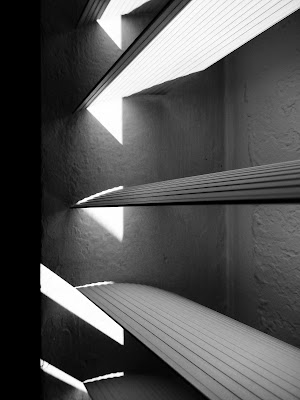Plastic shutters unusual perspectives with the sun of 7.30 AM through them. Or how to look at banal architectural objects from an artistic point of view.
Perspectivas inusuales de unas persianas de plástico con el sol de las 7.30 AM a través de ellas. O cómo mirar los objetos banales de la arquitectura desde un punto de vista artístico.
Para ilustrar con palabras acerca de encontrar el arte (la estética) en las pequeñas cosas, citaré a Benedetto Croce:
¨....algunas expresiones harto complicadas y difíciles aciertan a manifestarse con excelencia y se las llama obras de arte. Los límites de las expresiones -intuiciones que se denominan arte, con relación a las que se califican de no arte- son empíricos y es imposible definirlos. Un epigrama pertenece al arte; ¿porqué no una palabra sencilla? Un cuento pertenece al arte; ¿porqué no una simple nota de información periodística? Un paisaje pertenece al arte; ¿por qué no un esbozo topográfico? (.....) así tampoco puede haber una ciencia de las grandes intuiciones y otra de las pequeñas, una de la intuición común y otra de la intuición artística, sino una sola estética, ciencia del conocimiento intuitivo o expresivo, que es el hecho estético o artístico. Esta estética se corresponde perfectamente con la lógica, que abraza, como cosas de la misma naturaleza, la formación del concepto más pequeño y ordinario y la construcción del más complicado sistema científico y filosófico.¨
Benedetto Croce. Estética. pp 98-99. Ediciones Nueva Visión, Buenos Aires, 1969






















